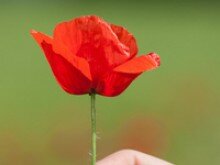Poetry and the Good Girl Syndrome, an interview with Anamika
Hindi poet Anamika on rabbits, telling it slant, and translation as hopscotch, crossword puzzle and X-ray.
AS: Would you like to begin by talking about your journey through five collections of poetry? How have your preoccupations changed or deepened over the years?
A: Journey? It’s been the journey of a rabbit in a submarine. During the World War, I believe submarine rabbits were used as radars. Their fur stood erect at the slightest signal . . . They could smell that things were going fishy but didn’t have the voice to protest . . . So imagine if they’d started writing. I must have been one of those silly rabbits – looking for the right kind of words to express what they feel when things go wrong, when everything is falling apart!
My first few collections were full of images drawn from Nature basically because Nature was my only playmate then. But people fascinated me too, especially women. As I grew up, I noticed how profound most of them were, and how oppressed! Full of anecdotes, riddles, strange stories, witty folklore, most of the small town women of this country are profusely sad and unbelievably vibrant at the same time.
We have a unique composite culture, a unique moral geography of our own, where gods and ghosts, animals and birds, the flora and the fauna, even the tiniest insects live together in a strange amity – almost under the same roof. Women even talk to trees and rivers, gods and ghosts. They worship them and fight with them and weather the same oppressions and calamities. Despite caste and class divides, supernatural and human elements here emerge as one family, constantly operating under the acute pressures of a lively love-hate relationship. This gives women a unique linguistic force which needs to be exploited to the full when one chooses to write about them. This needs to be explored with a zoom lens, because it means probing their relation to themselves, to theirpsychic and libidinal energies.
When I came to Delhi for my Masters, I realized that women all the world over suffer from the same ‘Good Girl’ syndrome. But there is a way out! As I read Sylvia Plath, Anne Sexton, Margie Pierce, Toni Morrison, Alice Walker and others, my sisterhood was more clearly defined. The notions of ‘respectability’ and ‘dignified suffering’ fascinate me still, but at least I try my level best to steer clear of the various layers of censorship.The urge to tell the truth, but “tell it slant” [ed. Emily Dickinson], keeps me going somehow!
AS: Why poetry? Is it linked to the ‘spiritual dieting’ you’ve spoken about – the ‘needle-and-thread’ syndrome by which middle class women keep their lips sealed and observe the “aesthetics of silence”?
A: I was a very lonely child. We had a huge house and I led a very isolated kind of life. There was an extensive library that I could use and I was told many bedtime stories. My father made a point of coming to spend a few hours with me at night talking and reading, but in the daytime I was completely alone. So all the characters from the books I read became the permanent citizens of my imagination.
And then others who were close to us, aunts, classmates, other women, women in distress, I would listen to their stories, their pain, and it was like a parallel world. Because I couldn’t talk about these things, I started writing about them. I was very close to my mother, but there were some experiences I just couldn’t share with her.
You know, I generally don’t talk about things and that is why I write. Maybe if I had had a friend or somebody to talk to I may not have had the urge to write. But because I do not always have a companion, I need to write about whatever happens, within and without. And I find poetry more fulfilling. I don’t know why – maybe because images are full of layers, so I feel I can express myself better through an image than through details.
Concealment or sublimation in women’s writing is common – it’s a defense mechanism, a form of censorship. It’s oblique, so people can read it any way they like and if they don’t want to, they needn’t. Anyway, who takes women’s writing seriously? Maybe ultimately one conceals things from oneself. It must be that.
AS: You have talked about certain Indian women writers whose work has been particularly inspirational to you – Katyayani, Shagufta, Prathibha Nandakumar, Pragnya Lokhande. What is it exactly that draws you to their work?
A: Poets of my choice deal with relational reality, containment, looking in and out. Their poems are sometimes exhortations, sometimes pure clinical analysis. But then the poets of the twentieth century are not in a position to anatomize pain, hope and love. There is no puritanical didacticism possible there. Culture, history, family and self are inextricably connected and layered, like Suleiman’s documents, or folded into each other. And the patriarchal divide between the personal and the political is gone with the wind!
I respond very well to your poems, and Fehmida Riaz’s also, because they deal with the filial and collective continuities, replaying bio-mytho-graphical memoirs in the tradition of African feminism. Memory plays the role of the Prime Mover and a subtle sense of irony cuts across it. This is true of the poetics of the other writers too: Shagufta, Kishwar Nahid, Katyayani, Prathibha Nandakumar and Pragnya.
AS: You’ve been active as a creative writer and an academic. In addition to your poetry and fiction, you’ve done a fair amount of criticism and translation as well. How does this feed into your poetry?
A: Both my criticism and translation have been my flying arcade games. I inhale and my chest expands. I reach out and I feel fuller. Looking into somebody else’s creation, deconstructing or translating it, has always been very satisfying.
What is writing if not the ‘criticism’ of life and also the tentative ‘translation’ of words and half-ideas that float inside you? ‘Critical’ and ‘creative’ are Siamese twins and each utterance is a translation – either of your own Bhoorjpatra or somebody else’s. I don’t see a chasm there.
Aesthetics and ethics are also Siamese twins. Things that are aesthetically frustrating are ethically repulsive too – violence, for instance. In most of the cases, aesthetics and ethics, the critical, the creative and the translational blend well. Like Enid Blyton’s Famous Five, they make a gala group when they venture into poetry – anybody’s poetry!
I’ve talked before about the pleasures of translation. I’ve said that translating from English into Hindi is fun. It’s like playing hopscotch with an old friend, a sakhi. Translating from Hindi into English is also fun but that fun is more akin to the pleasures of playing a crossword puzzle which teases, irritates, challenges, and finally boils down to an issue of prestige.
As a feminist translator, I’d hate to ‘domesticate’ a work that I translate because of the violence implicit in the term. Even if the target language is one’s own, one would not wish to domesticate the source language like a ‘cow’. At best, one could make it feel at home the way one would make Sylvia Plath, Anne Sexton, Adrienne Rich, Margie Pierce or other sisters from the other side of the world feel at home if one day they visited our angan or zenana. We would offer them everything we’d cooked, but if it didn’t suit their system, we wouldn’t force it down their throats. That is not hospitality: forcing something down someone’s throat. And this is what we have suffered down the ages, so resist we must.
A translation is a revelation, a friendship between poets, but it is also an act of criticism. The translator begins with the advantage of selecting the poem that lends itself to her translation. A translation is an X-ray and not a Xerox, fine, but how does one react when one comes across a male translators’ positivist manoeuvre of ‘civilising’ the text? For instance, many translators end up gender-neutralising women’s writing. This is why I believe it is important for a woman to translate a woman, or to play her midwife. Only the wearer knows where the shoe pinches!
AS: What about the contemporary Hindi poetry scene? How would you describe it?
A: The Hindi public sphere is to India what India is to the world: economically shattered, politically damned and culturally diverse. Regions that have suffered oppression and discrimination of all kinds, regions rich in racial memories – all of them inhale and exhale poetry or philosophy. There are around 500 little magazines and many good poets here, both young and old. There are at least three generations and five schools of poets! We feel like a big family (and of course, there are the family feuds too).
Kedarnath Singh, Uday Prakash, Alok Dhanera, Vimal Kumar, Katyayani, Rajesh Joshi, Nilesh Raghuvanshi – are my family of friends. But my real guru was my father, the late Shyamnandan Kishore, whose beautiful poems flash in my memory at the oddest of hours. He died early and belonged to the great Age of Radio.
To read most of these poets of my choice is to understand, question, know, forget, erase, deface and recover all the half-ideas, the sediments of half-thought that pester us continuously!
Written for PIW, 2006
Notes:
* Angan: courtyard
* Zenana: the women's quarters; that part of the home reserved for the women of thehousehold.
* Bhoorjpatra (or Bhojpatra): a document made from layers of the bark of the silverbirch tree on which ancient sacred texts and diagrams were inscribed








